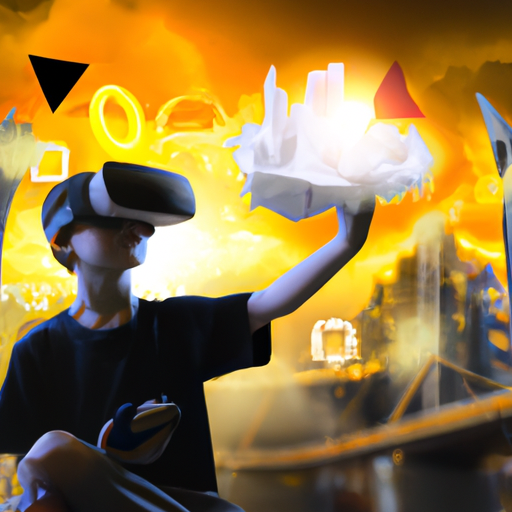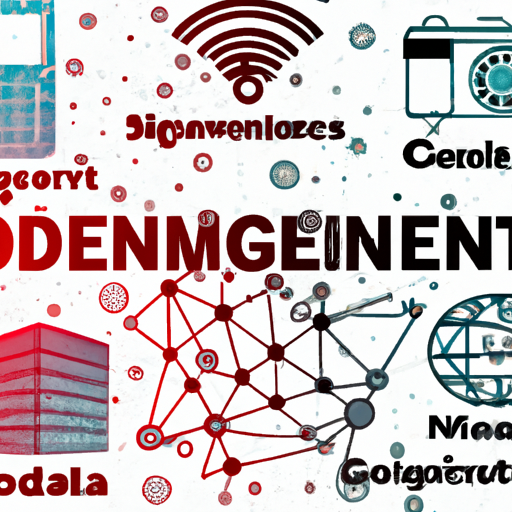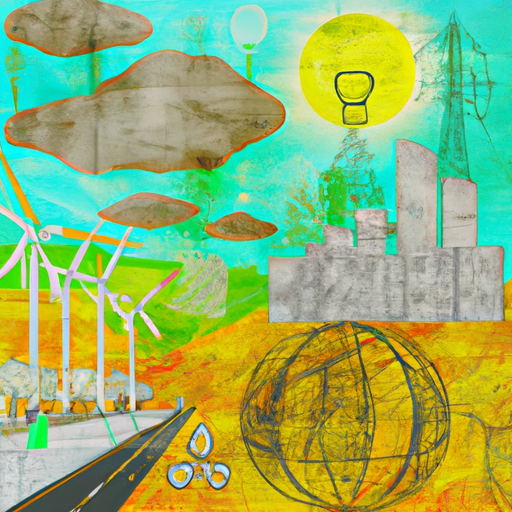-
Table of Contents
- Introduction
- How Virtual and Augmented Reality are Changing the Entertainment and Media Landscape
- Exploring the Potential of Virtual and Augmented Reality in the Entertainment and Media Industries
- The Impact of Virtual and Augmented Reality on the Future of Entertainment and Media
- How Virtual and Augmented Reality are Transforming the Way We Experience Entertainment and Media
- Conclusion
“Experience the Future of Entertainment and Media: Unlock a World of Virtual and Augmented Reality!”
Introduction
The future of entertainment and media is an exciting one, with the potential to revolutionize the way we experience and interact with content. Virtual and augmented reality are two of the most promising technologies that are set to revolutionize the entertainment and media industry. Virtual reality (VR) is a computer-generated simulation of a three-dimensional environment that can be interacted with in a seemingly real or physical way. Augmented reality (AR) is a technology that overlays digital content onto the real world, allowing users to interact with the environment in a more immersive way. Both technologies have the potential to revolutionize the way we experience entertainment and media, from gaming to movies, music, and more. With the rise of 5G networks, these technologies are becoming more accessible and affordable, allowing more people to experience them. This article will explore the potential of virtual and augmented reality in the entertainment and media industry, and how they can shape the future of entertainment and media.
How Virtual and Augmented Reality are Changing the Entertainment and Media Landscape
The entertainment and media landscape is undergoing a dramatic transformation due to the emergence of virtual and augmented reality (VR and AR). These technologies are revolutionizing the way people experience entertainment and media, allowing them to become more immersed in the content they consume.
VR is a computer-generated simulation of a three-dimensional environment that can be interacted with in a seemingly real or physical way. It is typically experienced through a headset, which allows users to explore virtual worlds and interact with objects within them. AR, on the other hand, is a technology that overlays digital content onto the real world. It is typically experienced through a smartphone or tablet, and allows users to view digital content in the context of their physical environment.
The entertainment and media industries are leveraging these technologies to create new and immersive experiences for their audiences. For example, VR is being used to create interactive video games, allowing players to explore virtual worlds and interact with characters and objects within them. It is also being used to create virtual movie theaters, allowing viewers to watch films in a simulated environment. AR is being used to create interactive experiences, such as augmented reality apps that allow users to explore digital content in the context of their physical environment.
These technologies are also being used to create new forms of storytelling. For example, VR is being used to create interactive documentaries, allowing viewers to explore virtual worlds and interact with characters and objects within them. AR is being used to create interactive experiences, such as augmented reality apps that allow users to explore digital content in the context of their physical environment.
The emergence of VR and AR is transforming the entertainment and media landscape, allowing content creators to create more immersive and interactive experiences for their audiences. These technologies are enabling content creators to tell stories in new and innovative ways, allowing viewers to become more immersed in the content they consume. As these technologies continue to evolve, they will continue to revolutionize the way people experience entertainment and media.
Exploring the Potential of Virtual and Augmented Reality in the Entertainment and Media Industries
The entertainment and media industries have been revolutionized by the emergence of virtual and augmented reality (VR/AR). This technology has the potential to create immersive experiences that can transport users to new worlds and provide them with a unique perspective on the world around them.
VR/AR technology is being used in a variety of ways in the entertainment and media industries. In the film and television industry, VR/AR can be used to create immersive experiences that allow viewers to explore a scene from multiple angles. This technology can also be used to create interactive experiences that allow viewers to interact with characters and objects in a scene.
In the gaming industry, VR/AR can be used to create immersive gaming experiences that allow players to explore virtual worlds and interact with characters and objects in a realistic way. This technology can also be used to create interactive experiences that allow players to interact with characters and objects in a scene.
In the music industry, VR/AR can be used to create immersive experiences that allow listeners to explore a song from multiple angles. This technology can also be used to create interactive experiences that allow listeners to interact with characters and objects in a scene.
In the advertising industry, VR/AR can be used to create immersive experiences that allow viewers to explore a product from multiple angles. This technology can also be used to create interactive experiences that allow viewers to interact with characters and objects in a scene.
The potential of VR/AR technology in the entertainment and media industries is immense. This technology can be used to create immersive experiences that allow viewers, listeners, and players to explore new worlds and interact with characters and objects in a realistic way. As the technology continues to evolve, the possibilities for creating unique and engaging experiences are endless.
The Impact of Virtual and Augmented Reality on the Future of Entertainment and Media
The emergence of virtual and augmented reality (VR and AR) technologies has revolutionized the entertainment and media industries. These technologies have enabled users to experience immersive, interactive, and engaging content in ways that were previously unimaginable.
VR and AR have the potential to completely transform the way people consume entertainment and media. For example, VR can be used to create immersive, interactive experiences that allow users to explore virtual worlds and engage with characters and objects in a way that is not possible with traditional media. Similarly, AR can be used to overlay digital content onto the real world, allowing users to interact with the environment in a more natural and engaging way.
In addition to providing a more immersive experience, VR and AR can also be used to create more personalized content. For example, VR can be used to create personalized experiences tailored to the user’s interests and preferences. Similarly, AR can be used to create interactive experiences that are tailored to the user’s location and context.
Finally, VR and AR can also be used to create more interactive and engaging content. For example, VR can be used to create interactive games and experiences that allow users to interact with the environment in a more natural and engaging way. Similarly, AR can be used to create interactive experiences that allow users to interact with digital content in the real world.
Overall, the emergence of VR and AR technologies has had a profound impact on the entertainment and media industries. These technologies have enabled users to experience immersive, interactive, and engaging content in ways that were previously unimaginable. As these technologies continue to evolve, they will continue to revolutionize the way people consume entertainment and media.
How Virtual and Augmented Reality are Transforming the Way We Experience Entertainment and Media
The entertainment and media industries have been revolutionized by the introduction of virtual and augmented reality (VR and AR). These technologies have enabled users to experience content in a completely new way, immersing them in a virtual world and allowing them to interact with it in a way that was previously impossible.
VR is a computer-generated simulation of a three-dimensional environment that can be interacted with in a seemingly real or physical way. It is typically experienced through a headset, which allows the user to be fully immersed in the virtual world. This technology has been used to create a variety of experiences, from video games to virtual tours of historical sites.
AR, on the other hand, is a technology that overlays digital content onto the real world. It is typically experienced through a smartphone or tablet, and can be used to enhance the user’s experience of the real world. For example, AR can be used to provide additional information about a particular object or location, or to add a layer of interactivity to a physical environment.
VR and AR have had a profound impact on the entertainment and media industries. For example, VR has enabled filmmakers to create immersive experiences that allow viewers to feel as if they are actually in the movie. This has opened up new possibilities for storytelling, as filmmakers can now create experiences that are more interactive and engaging than ever before.
AR has also been used to create interactive experiences that allow users to interact with their environment in a more meaningful way. For example, AR can be used to create interactive games that allow users to explore their environment and interact with objects in a more engaging way.
In addition, VR and AR have enabled media companies to create more engaging and interactive experiences for their audiences. For example, media companies can now create virtual reality experiences that allow viewers to explore a virtual world and interact with it in a more meaningful way. This has opened up new possibilities for storytelling, as media companies can now create experiences that are more immersive and engaging than ever before.
Overall, VR and AR have revolutionized the way we experience entertainment and media. These technologies have enabled us to experience content in a completely new way, immersing us in a virtual world and allowing us to interact with it in a way that was previously impossible. As these technologies continue to evolve, we can expect to see even more innovative and engaging experiences in the future.
Conclusion
The future of entertainment and media is looking very exciting, with the potential for virtual and augmented reality to revolutionize the way we experience media. Virtual reality has the potential to create immersive, interactive experiences that can transport us to new worlds, while augmented reality can bring the digital world into our physical environment. With the continued development of these technologies, we can expect to see more and more innovative ways to experience entertainment and media in the future.




